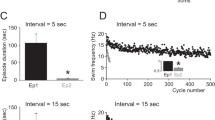Abstract
This paper investigates the proposal that the frequency of the swimming central pattern generator in young Xenopus tadpoles is partly determined by the population of glutamatergic premotor interneurons active on each cycle. During fictive swimming spinal neurons also receive cholinergic and electrotonic excitation from motoneurons. As frequency changes during swimming we make two predictions: first, since most motoneurons fire very reliably at all frequencies, the electrotonic and nicotinic drive from motoneurons should remain constant, and second, when swimming frequency decreases, the glutamatergic drive should decrease as the number of active premotor excitatory interneurons decreases. We have tested these predictions by measuring the excitatory synaptic drive to motoneurons as frequency changes during fictive swimming. The components of synaptic drive were revealed by the local microperfusion of strychnine together with different excitatory antagonists. After blocking the nicotinic acetylcholine receptor, the mainly glutmatergic excitatory synaptic drive still changed with frequency. However, when glutamate receptors or all chemical transmission was blocked, excitation did not change with frequency. Our predictions are confirmed, suggesting that premotor excitatory interneurons are a major factor in frequency control in the tadpole central pattern generator and that motoneurons provide a stable background excitation.
Similar content being viewed by others
Author information
Authors and Affiliations
Additional information
Accepted: 14 August 1998
Rights and permissions
About this article
Cite this article
Zhao, FY., Roberts, A. Assessing the roles of glutamatergic and cholinergic synaptic drive in the control of fictive swimming frequency in young Xenopus tadpoles. J Comp Physiol A 183, 753–758 (1998). https://doi.org/10.1007/s003590050298
Issue Date:
DOI: https://doi.org/10.1007/s003590050298




